Raft-Away River
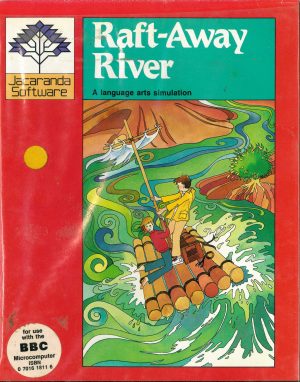 Game Meta:
Game Meta:“Raft-Away River” is an adventure simulation game for two to six players. It is designed to encourage the social skills of effective communication, co-operative behaviour, and problem solving as a group. It also stimulates reading, comprehension and the interpretation of pictorial information.
The game is set on a river bank, following a rafting calamity. As one of the players, you are stranded on the west bank of the river near a cave. The river is the only means of escape, so another raft must be built; but with what? There is insufficient timber on the west bank, so another means must be found to reach the forest on the other side. You and your companions’ problems are multiplied by hunger, cold and the threat of imminent rain and flooding. To escape from this threatening situation requires careful planning and co-operation, using the tools with which you have been provided.
“Raft-Away River” can be played at several levels of difficulty, and the random elements which are incorporated into the program design mean different strategies must be worked out whenever the game is played. Although designed primarily for the promotion of language development and communication, the program’s flexibility enables it to reach a much wider audience. It can be introduced whenever emphasis is placed on leadership, communication, cooperative behaviour and strategic planning.
The program runs on a BBC/B microcomputer with 40/80 track disk drive. This package is supported by a teacher’s manual and a student’s guide.
The Software came packaged with teachers notes and student guides.

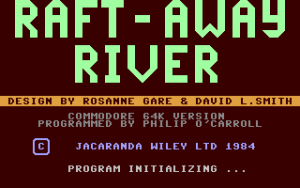
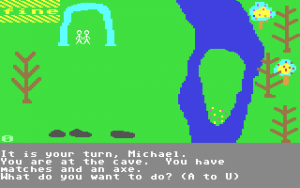

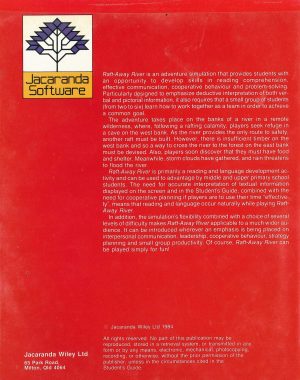

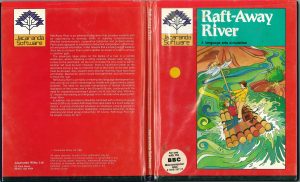

Raft Away River was also available for the Apple // and MicroBee. It was essentially an edutainment title and built up the players planning, puzzle-solving and team-player skills. There was also an element of risk judgement required. For example the players had to judge whether to risk eating potentially poisonous berries or go hungry while fish was getting caught/cooked), or go and rest while feeling ill or keep working to get things done.
Players were randomly assigned four items (axe, fishing line, matches and rope). These could be used to cut wood, catch fish, light pile of wood, build bridge or build raft, depending on where the player was located on the map.
On the easiest setting for Primary School players, the game could be completed after several attempts. In retrospect, as long as the players didn’t do anything stupid (like burning too much wood in the fireplace or doing too little of a certain task), there was a good chance of either completing or almost completing the game. The Hardest setting requires a bit of luck (due to random events like rain) and perfect timing/action of events.
The key actions (from the Apple // version) were as follows:
A: Go and rest or shelter in the cave
B: Go to the tree
C: Go to the fireplace
D: Go to the fireplace carrying a log
E: Go to the West Bank
F: Go to the West Bank carrying a log
G: Go to the island
H: Go to the island carrying a log
I: Go to the East bank
J: Go to the East bank carrying a log
K: Cut wood
L: Build the bridge
M: Build the raft
N: Take a log from the raft
O: Look for gemstones
P: Try to catch a fish
Q: Put wood from the pile on the fire
R: Light the fire
S: Cook your fish
T: Eat some fish
U: Eat some berries
The axe could only be used at the tree or East bank. The fishing line could only be used at the West Bank. The matches could only be used at the fireplace (and only if there was wood on it). The rope could be used at the West Bank (to build the raft or Western part of the bridge) or on the island (to build the Eastern part of the bridge).
A good strategy was to catch and cook your fish before anyone got hungry. The cooked fish could be left on the fireplace (the fire would burn itself out) and eaten when the players got hungry. In some ways this was perhaps a design flaw (shouldn’t the player get sick if the cooked fish is too old) but may have been too hard for the intended audience if it were implemented.
A game with more players gave good opportunity to have log carriers move logs to the required areas and then later in the game to search for gemstones on the island.
Apple II intro screen
Attached image:
Apple II version – cooking a fish
Attached image:
Apple II version – looking for gemstones
Attached image:
Apple II version – the raft is finished
Attached image:
Apple II version – the ending
Attached image:
Raft-Away River Microbee version was very popular in schools, though their choice of colour for text made it difficult to read.
Alan
Attached image:
I love reading forum accounts of people searching for this game, and their trying to recall the name of this game they played at school (like the forum threads at http://forums.whirlpool.net.au/archive/1339021 and http://www.dosgames.com/forum/post-22459.html). It seems likely that these educational games were often one of the first (if not the first) games many people played, so they summon up powerful memories.
Raft-Away River was certainly one of the first educational games I had exposure to. I don’t remember a lot from the time but I do remember that it was at Primary School (probably only a year or two after the titles release). I do remember that Raft-Away River and Where in the World is Carmen Sandiego were the only two games that were ever presented to us in school (and this was at a time when you only got a fews days access to computers every year – remember that these things were probably the equivalent of something like 10 weeks wages back in the 1980’s). In retrospect, it is quite an achievement for the small local publisher given that Carmen Sandiego was produced by a significantly larger company.
Regarding the colouring in the Microbee version, I believe it is all BASIC code and one could probably search through the code and change it to something more readable (that is if one could stand the way BASIC code was listed on the Microbee – I don’t like it).
Ah, spent many lunchtimes on this in primary school. Co-op survival with crafting aspects – this game had it all long before the modern bandwagon! I don’t think we ever managed to beat it, but it was fun to try.